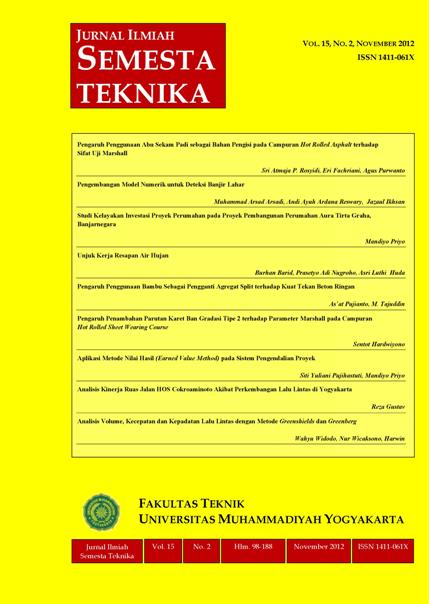Pengaruh Penambahan Parutan Karet Ban Gradasi Tipe 2 terhadap Parameter Marshall pada Campuran Hot Rolled Sheet Wearing Course
DOI:
https://doi.org/10.18196/st.v15i2.1358Keywords:
HRS, Marshall Properties, Shredded Tire RubberAbstract
The provision of road infrastructure cannot be separated with the pavement construction itself. One of the materials used is asphalt that is really related to natural resources. Using asphalt is not durable in many cases because of the oxidation process, mainly due to heating. This can lead the road (flexible pavement) to fast deformation, including cracking. Nowadays, there are many additives to improve the asphalt quality. One of them is adding rubber to the asphalt which can give more durability under high temperatures, increase its adhesion, and improve its flexibility. This study used the additives in the form of shredded rubber with the content of 20%, 21%, and 22% of the total mass of asphalt. The shredded rubber was mixed with the asphalt, and then heated at least 45 minutes before mixing it with the aggregates. The HRS WC mixture with the tire rubber was compared in term of optimum asphalt content and Marshall results. The results show that adding shredded tire rubber in HRS WC mixture can decrease the flow. This shows that the addition of shredded rubber can decrease of the sample deformation, so that the mix will not be too plastic and easily deformed under the loading. It can also increase the VIM and decrease the VFA, so that it can reduce the bleeding possibility.
Downloads
How to Cite
Issue
Section
License
Semesta Teknika is licensed under a Creative Commons Attribution 4.0 International License.
Authors who publish with this journal agree to the following terms:
- Authors retain copyright and grant the journal right of first publication with the work simultaneously licensed under a Creative Commons Attribution License that allows others to share the work with an acknowledgement of the work's authorship and initial publication in this journal.
- Authors are able to enter into separate, additional contractual arrangements for the non-exclusive distribution of the journal's published version of the work (e.g., post it to an institutional repository or publish it in a book), with an acknowledgement of its initial publication in this journal.
- Authors are permitted and encouraged to post their work online (e.g., in institutional repositories or on their website) prior to and during the submission process, as it can lead to productive exchanges, as well as earlier and greater citation of published work (See The Effect of Open Access).









